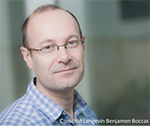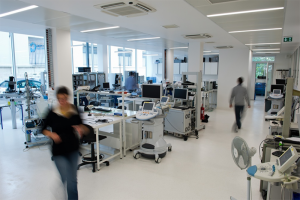The Wave Physics for Medicine and Biology laboratory is a leading biomedical research center. They are developing innovative imaging concepts ranging from the cellular level (using optical waves) to internal organs (using ultrasound waves), and creating and patenting therapeutic innovations in focused ultrasound.
Headed by Dr. Mickaël Tanter, the laboratory is within the Institut Langevin in Paris. Since research spans from basic science to clinical translation, the laboratory is affiliated with the French National Institute of Health (Inserm), the French National Center for Research (CNRS), and the ESPCI ParisTech School of Engineering.
We interviewed Dr. Jean-François Aubry to learn more about the laboratory and their projects.
Site Name/Location(s): ESPCI ParisTech (Ecole Supérieure de Physique et Chimie Industrielles)
Name of laboratory/Institution: Wave Physics for Medicine and Biology/Institut Langevin
Institutions: ESPCI, INSERM, CNRS
Q. What is the site’s vision and mission?
Our main focus is to propose cutting-edge approaches for screening, diagnostic imaging, and therapy from bench to bedside with a worldwide renowned know-how in clinical and technology transfer. Ultrafast ultrasound imaging, shear wave elastography, functional ultrasound (fultrasound) imaging, ultrasound localization microscopy, and CT-based adaptive focusing techniques are among the concepts introduced by the medical team.
We are currently developing innovative techniques for medical imaging and extracorporeal therapy based on the use of ultrasonic, optical, or electromagnetic waves. This work consists of the development of unique research platforms and preclinical and clinical validation of these concepts.
Q. Where does your funding come from?
We receive funding from the Agence Nationale de la Recherche (ANR), European grants (ERC European Research Council), and Industrial Contracts.
Q. How many total staff in each position?
Under the guidance of our team leader, Dr. Mickaël Tanter, this research site employs 13 researchers, 4 engineers, 4 assistant engineering/administrative staff, 3 hospital practitioners, 10 post-doctoral students, and 15 PhD students for a total of just under 50 people.
Q. Who are your key Investigators?
Dr. Mickaël Tanter has been the head of the research team for more than ten years. He is involved in most research areas of the team. The four senior investigators who are coordinating the four main research interest areas are:
- Jean-Luc Gennisson – DIAGNOSTIC ULTRASOUND-BASED IMAGING, including shear wave elastography, contrast imaging, and molecular imaging.
- Mathieu Pernot – FUNCTIONAL ULTRASOUND-BASED IMAGING, including cardiac functional imaging and functional ultrasound imaging of the brain.
- Jean-François Aubry – ULTRASOUND BASED THERAPIES, including transcranial ultrasound therapy and drug delivery.
- François Ramaz – OPTICAL IMAGING, including photoacoustic, acousto-optics, and optical coherence tomography (OCT).
Q. What are the professional history and credentials of the site’s lead investigators?

Mickaël Tanter is a Research Professor at the French National Institute for Health and Medical Research, the Director of the Wave Physics for Medicine laboratory, and the Deputy Director of Institut Langevin at ESPCI ParisTech. He is a world renowned expert in biomedical ultrasound and wave physics with 40 patents and more than 220 peer-reviewed papers and book chapters. In 2006, he co-founded SuperSonic Imagine, an innovative medical ultrasound imaging and therapy company that launched a revolutionary ultrafast platform called AixplorerTM with a unique real-time shear wave imaging modality for cancer diagnosis. He co-invented several major innovations in biomedical ultrasound (transient elastography, ultrafast ultrasound using plane wave imaging, functional ultrasound imaging of brain activity, and recently, deep ultrasound localization microscopy), and has received many national and international awards (among them the Honored Lecture of the Radiology Society of North America in 2012 and the Grand Prize of Medicine and Medical Research of Paris). In 2014, he was awarded a prestigious European Research Council (ERC) Advanced Grant to introduce fUltrasound imaging (functional imaging of brain activity) as a new full-fledged neuroimaging modality.

François Ramaz, PhD, is an Associate Professor at ESPCI ParisTech. He belongs to Institut Langevin and is a member of INSERM unit U979 (Physics of Waves for Medicine and Biology). He obtained his PhD in Physics at the Université Joseph Fourier (Grenoble – France) for his work on hole-burning spectroscopy in rare-earth doped inorganic crystals. He has been involved at ESPCI ParisTech on the spectroscopic characterization of photorefractive materials using magneto-optic techniques (magnetic circular dichroism). At present, he is involved in acousto-optic imaging techniques for medicine and biology and develops original adaptive holographic methods of detection, with cameras of photosensitive materials (photorefractive and gain media).

Jean-Luc Gennisson received his PhD in Acoustical Physics from Paris VI University for his work on elastography. From 2003 to 2005, he worked at the laboratory of bio-rheology and medical ultrasound in Montreal with Pr. Guy Cloutier then became a research scientist at CNRS. Since 2013, he has been in charge of diagnostic ultrasound imaging. His research interests include medical ultrasonic imaging, shear wave propagation in soft tissues for cancer detection, nonlinear shear waves, ultrafast ultrasound imaging, and functional ultrasound.

Jean-François (Jeff) Aubry is director of research at CNRS. He is a member of the Wave Physics for Medicine and Biology Laboratory at Institut Langevin and is an invited associate professor at the University of Virginia Department of Radiation Oncology. His research interests are MR-guided transcranial brain therapy and ultrasound-guided trans-costal liver therapy, ultrasonic motion detection and motion correction, high resolution cavitation mapping, and ultrasonic brain imaging. Aubry holds four patents on adaptive focusing and has been a consultant for SuperSonic Imagine on MR-guided brain therapy. In 2011, he received the ISTU Frederic Lizzi Early Career Award and the CNRS bronze medal. Aubry serves on the editorial board of the Journal of Therapeutic Ultrasound and is Associate Editor of Medical Physics. A member of the Foundation’s Research Advisory Committee, he is also the current President of ISTU (2015 – 2018).

Mathieu Pernot is a research scientist at INSERM and a permanent member of the Wave Physics for Medicine and Biology team since 2007. His research interests focus on the development of ultrafast ultrasound imaging and therapeutic ultrasound with a special interest on cardiovascular applications. In 2012, he received a prestigious award from the European Research Council (€1.5 M€ ERC starting grant) for his research on ultrafast imaging of the human heart and early diagnosis of heart failure. As a principal investigator, he has raised more than €3 million from the European Research Council, the French national research agency, and French innovation program in ultrasound imaging and therapy. He and his co-authors received the IEEE UFFC Outstanding Paper Award in 2010 and the Robert’s prize in 2015.
Q. Who are your internal and external collaborators?
Our external collaborators on clinical and pre-clinical projects include the more than 30 scientists listed below.
Clinical Investigators:
Curie Institute Radiology (Drs. Servois, Athanasiou, and Tardivon)
Cochin Institute Hepatology (Prof. Pol, Inserm) and Endocrinology (Prof. Boitard)
Institut Cerveau & Moelle épinière, CENIR (Prof. Lehericy, Inserm)
Pitié Salpêtrière Hospital Neurosurgery (Drs. Boch, Karachi, Chauvet, Capelle)
G. Pompidou Hospital Cardiology (Prof. Messas, Inserm)
Pellegrin Hospital, Bordeaux, Radiology and Renal Transplantation (Prof. Grenier)
Robert Debré Hospital Neonatology (Prof. Baud)
Necker Hospital Radiology and Nephrology (Prof. Correas)
Beaujon Hospital Radiology (Prof. Vilgrain)
Pre-clinical Investigators:
Institut Cerveau & Moelle épinière (Pierre Pouget)
IHU Neuroscience Epilepsy (Dr. Cohen, Inserm)
Pitié Salpêtrière Hospital, Epilepsy (Dr. Cohen, Inserm)
G. Pompidou Hospital Nuclear Imaging, PARCC (Pofr. Tavitian)
Pellegrin Hospital, Bordeaux, Opthalmology (Dr. Touboul)
Port Royal Maternity Clinic Ob/Gyn (Dr. Tsatsaris)
Institut Curie Biology (Dr. Johannes, Inserm)
Faculty of Pharmacy, Chatenay Malabry Cardiac Physiology (Prof. Fischmeister, Inserm)
Institut de la Vision (Profs. Sahel, Picaud, Paques)
Laboratoire Microfluidique, ESPCI Drug Delivery (Prof. Tabeling)
IHU Bordeaux Atrial Fibriallation (Prof. Haissaguere)
Institut Curie Biophysics of Cancer (E. Farge)
ESPCI Neurobiology Laboratory (Z. Lenkei)
University of Paris V (Prof. Charpak)
Laboratoire Ciceron, Caen (Prof. Vivien)
University of Nantes Medical School (Prof. Layrolle)
University of Virginia, VA, USA (Dr. Elias, Prof. Sheehan, Prof. Larner, Dr. Schlesinger, W. Miller, M. Wintermark)

Q. What types of facilities, space, and equipment do you have?
We have 1,200 m2 of research space at ESPCI for developing new technologies and 200 m2 at ICM (Institut du Cerveau de de la Moelle, Pitié Salpétrière Hospital, Paris) for preclinical and clinical therapeutic applications. We also collaborate with many hospitals where we perform preclinical and clinical trials (see prvious question).
Q. Which FUS applications and biomechanisms are being investigated?
- Diagnostic applications: ultrafast B-mode imaging, elastography, ultrafast Doppler imaging, ultrasonic functional imaging.
- Therapeutic applications: thermal therapies, neuromodulation, drug delivery
- Safety studies: active and passive cavitation mapping, pressure field estimation in the brain (for thermal therapy, neuromodulation and sonothrombolysis)
Q. What are your projects?
- Ultrasonic functional imaging (fUS)
- Brain therapy (thermal therapy, drug delivery and neuromodulation)
- Novel cardiac imaging
Q. What are your successes?
- Most recent success: http://fultrasound.eu/in-vivo-super-resolution-vascular-imaging/
- Many successes about ultrasonic functional imaging (fUS) described at http://fultrasound.eu/
- Creation of SuperSonic Imagine by Jacques Souquet and Claude Cohen-Bacri based on the patents of the medical team on ultrafast imaging and aberration correction techniques
- First ultrasonic neuromodulation on primates
Q. Has the Foundation played a role in your work?
Guillaume Maimbourg was funded as a global intern in 2015. His positive experience inspired him to pursue a PhD with our group.
The Foundation has funded two of our projects: numerical investigation of standing waves in the brain (PI: JF Aubry) and Direct Correction of Transcranial Ultrasonic Focusing based on MR-ARFI guidance (PI: M. Tanter).
Far beyond the funding of two projects, the Foundation has impacted our research by accelerating our research in many ways. They have:
- increased awareness about focused ultrasound among patients to facilitate clinical trials,
- made connections with other foundations to pave the way for new sources of funding, and
- gathered researchers together to share ideas on key issues.
Mickaël Tanter and Jean- François Aubry have participated in almost all of the brain-related workshops organized by the Foundation. These workshops are very efficient brainstorming sessions.
Finally, the Foundation also made it possible for Jean- François Aubry to spend a highly productive, one year fellowship at the University of Virginia in 2013, working on MR skull bone imaging, low frequency ultrasonic ablation, blood brain barrier opening, trans-hair focusing, and many others. The collaboration is still ongoing.
Q. What is your wish list to increase your impact?
We wish to continue attracting engineers and young researchers to develop cutting edge hardware and software for diagnostic and therapeutic application, and speed up the dissemination of the technology to hospitals and other research labs.
Q. What is your role in education?
All researchers teach optical and ultrasonic medical applications for bachelor’s, master’s, or doctoral degrees. Jean-François Aubry is the director of the Winter School on Therapeutic Ultrasound, together with Gail ter Haar (ICR, UK) and Vera Khokhlova (Moscow University, Russia). This school is held every two years at Les Houches, France (next session, March 28-31, 2017).
Q. What’s next?
- Transcranial functional brain imaging
- Thalamotomy with the SuperSonic Brain system
- 3D Cardiac elastography
Video footage: Mickaël Tanter explains fUltrasound imaging http://fultrasound.eu/
Past Coverage:
2015 Summer Intern: Guillaume Maimbourg (August 2015)
Ultrasonic Brain Therapy Expert, Jean-Francois Aubry, PhD, to be Visiting Associate Professor At UVA (July 2012)

